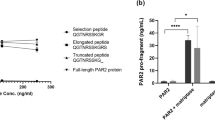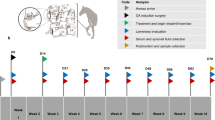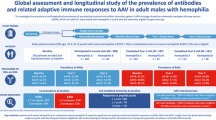Abstract
Osteoarthritis (OA) is a leading cause of disability with no cure and only supportive therapy. Adeno-associated virus (AAV) serotype 2.5 is being used in a Phase I clinical trial to deliver the interleukin-1 receptor antagonist into knee joints with OA. Neutralizing antibodies (Nab) directed against AAV2.5, if present, could inhibit gene transfer. Here, we report the prevalence of AAV2.5 Nab in the sera and synovial fluids of patients with OA. Nab titers were measured by their ability to inhibit in vitro transduction by AAV2.5 encoding GFP. Of 44 synovial fluids from patients with mid-stage and advanced OA, 43% had undetectable Nab; 25% had low titers (<1:100), 16% had medium titers (1:100–1:1000) and 16% had high titers (>1:1000) of Nab. Titers of AAV2.5 Nabs correlated with those of AAV2, but not with those of AAV5. Serum titers of AAV2.5 Nab correlated positively with titers in synovial fluid, and were never less than the matched synovial fluid titers. These findings suggest that high titers of Nab against AAV2.5 are uncommon in the synovial fluids of patients with OA, and individuals with high synovial fluid Nab titers can be identified by measuring titers in the serum.
This is a preview of subscription content, access via your institution
Access options
Subscribe to this journal
Receive 12 print issues and online access
$259.00 per year
only $21.58 per issue
Buy this article
- Purchase on Springer Link
- Instant access to full article PDF
Prices may be subject to local taxes which are calculated during checkout

Similar content being viewed by others
Data availability
Within the published article.
References
Evans CH, Ghivizzani SC, Robbins PD. Gene delivery to joints by intra-articular injection. Hum Gene Ther. 2018;29:2–14.
Evans CH, Kraus VB, Setton LA. Progress in intra-articular therapy. Nat Rev Rheumatol. 2014;10:11–22.
Mease PJ, Wei, Fudman NEJ, Kivitz AJ, Schechtman J, Trapp RG, et al. Safety, tolerability, and clinical outcomes after intraarticular injection of a recombinant adeno-associated vector containing a tumor necrosis factor antagonist gene: results of a phase 1/2 Study. J Rheumatol. 2010;37:692–703.
Mease PJ, Hobbs K, Chalmers A, El-Gabalawy H, Bookman A, Keystone E, et al. Local delivery of a recombinant adenoassociated vector containing a tumour necrosis factor alpha antagonist gene in inflammatory arthritis: a phase 1 dose-escalation safety and tolerability study. Ann Rheum Dis. 2009;68:1247–54.
Vrouwe JPM, Meulenberg JJM, Klarenbeek NB, Navas-Canete A, Reijnierse M, Ruiterkamp G, et al. Administration of an adeno-associated viral vector expressing interferon-beta in patients with inflammatory hand arthritis, results of a phase I/II study. Osteoarthritis Cart. https://doi.org/10.1016/j.joca.2021.09.013 (2021).
Burg M, Rosebrough C, Drouin LM, Bennett A, Mietzsch M, Chipman P, et al. Atomic structure of a rationally engineered gene delivery vector, AAV2.5. J Struct Biol. 2018;203:236–41.
Calcedo R, Wilson JM. Humoral immune response to AAV. Front Immunol. 2013;4:341.
Bowles DE, McPhee SW, Li C, Gray SJ, Samulski JJ, Camp AS, et al. Phase 1 gene therapy for Duchenne muscular dystrophy using a translational optimized AAV vector. Mol Ther. 2012;20:443–55.
Bessis N, GarciaCozar FJ, Boissier MC. Immune responses to gene therapy vectors: influence on vector function and effector mechanisms. Gene Ther. 2004;11:S10–17.
Cottard V, Valvason C, Falgarone G, Lutomski, Boissier DMC, Bessis N. Immune response against gene therapy vectors: influence of synovial fluid on adeno-associated virus mediated gene transfer to chondrocytes. J Clin Immunol. 2004;24:162–9.
Mingozzi F, Chen Y, Edmonson SC, Zhou S, Thurlings RM, Tak PP, et al. Prevalence and pharmacological modulation of humoral immunity to AAV vectors in gene transfer to synovial tissue. Gene Ther. 2013;20:417–24.
Boissier MC, Lemeiter D, Clavel C, Valvason C, Laroche L, Begue T, et al. Synoviocyte infection with adeno-associated virus (AAV) is neutralized by human synovial fluid from arthritis patients and depends on AAV serotype. Hum Gene Ther. 2007;18:525–35.
Georgescu HI, Mendelow D, Evans CH. HIG-82: an established cell line from rabbit periarticular soft tissue, which retains the “activatable” phenotype. In Vitro Cell Dev Biol. 1988;24:1015–22.
Watson Levings RS, Broome TA, Smith AD, Rice BL, Gibbs EP, Myara DA, et al. Gene therapy for osteoarthritis: pharmacokinetics of intra-articular self-complementary adeno-associated virus interleukin-1 receptor antagonist delivery in an equine model. Hum Gene Ther Clin Dev,. 2018;29:90–100.
Watson Levings RA, Smith AD, Broome TA, Rice BL, Gibbs EP, Myara DA, et al. Self-complementary adeno-associated virus-mediated interleukin-1 receptor antagonist gene delivery for the treatment of osteoarthritis: test of efficacy in an equine model. Hum Gene Ther Clin Dev. 2018;29:101–12.
Wang G, Evans CH, Benson JM, Hutt JA, Seagrave J, Wilder JA, et al. Safety and biodistribution assessment of sc-rAAV2.5IL-1Ra administered via intra-articular injection in a mono-iodoacetate-induced osteoarthritis rat model. Mol Ther Methods Clin Dev. 2016;3:15052.
Monahan PE, Negrier C, Tarantino M, Valentino LA, Mingozzi F. Emerging immunogenicity and genotoxicity considerations of adeno-associated virus vector gene therapy for hemophilia. J Clin Med. 2021;10:2471.
Acknowledgements
This work was supported by award number W81XWH-16-1-0540 from the Department of Defense. Dr. Abdul was supported by NIH training grant number NIH-NICHD T32 - 5T32GM00868F20. Dr. Evans’s research is supported, in part, by the John and Posy Krehbiel Professorship in Orthopedics. Figure 1 was created with BioRender.com.
Author information
Authors and Affiliations
Contributions
JS, JLS, MPA: Sample acquisition. TYA, GPH, JWW, MJC, REDLV: Assay development and implementation. REDLV, TYA, CHE: Data analysis. CHE, REDLV: Manuscript preparation.
Corresponding author
Ethics declarations
Competing interests
CHE is a co-founder of Genascence Inc., which is running a Phase I clinical trial in this area (ClinicalTrials.gov Identifier: NCT02790723).
Ethics approval
Mayo Clinic Institutional Review Board approval (IRB# 16-009183).
Additional information
Publisher’s note Springer Nature remains neutral with regard to jurisdictional claims in published maps and institutional affiliations.
Rights and permissions
About this article
Cite this article
Abdul, T.Y., Hawse, G.P., Smith, J. et al. Prevalence of AAV2.5 neutralizing antibodies in synovial fluid and serum of patients with osteoarthritis. Gene Ther 30, 587–591 (2023). https://doi.org/10.1038/s41434-022-00326-5
Received:
Revised:
Accepted:
Published:
Issue Date:
DOI: https://doi.org/10.1038/s41434-022-00326-5



